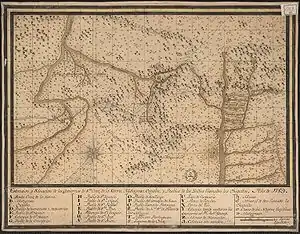Chiquitania
Chiquitania ("Chiquitos" or "Gran Chiquitania") is a region of tropical savannas in the Santa Cruz Department in eastern Bolivia.

"Chiquitos" is the colonial name for what is now essentially five of the six provinces that make up the Chiquitania, a region in Bolivia's Santa Cruz department. "Chiquitos" refers to a region, not a tribe. One of the many tribes inhabiting Chiquitos were the Chiquitano.[1]
The name Chiquitos means "little ones" in Spanish. It was chosen by the Spanish conquistadores, when they found the small doors of the Indian huts in the region. Around 20 ethnic groups live in the Chiquitania.
A notable feature are the 18th century Jesuit reductions and Franciscan settlements scattered throughout the region. Six churches still remain in the zone and were selected in 1990 as UNESCO World Heritage Sites under the name Jesuit Missions of the Chiquitos.
Thousands of fires swept through eastern Bolivia in August 2019,(August is the driest month in the region), to the fury of environmentalists and locals who accused the country's president, Evo Morales, of incentivising the blazes after he passed legislation in July that encourages slash-and-burn farming to create pasture and arable land. The Chiquitano dry forest is the ecosystem which connects South America's two largest biomes, the Amazon and the Gran Chaco, a dense dry forest of thorn-covered trees and scrub that extends south into Paraguay and Brazil. [2]
See also
References
- http://www.chiquitania.com Archived 2009-01-26 at the Wayback Machine: The two names Chiquitos and Chiquitano should not be confused, the first is a place; that second a tribe.
- https://www.theguardian.com/world/2019/sep/02/bolivia-evo-morales-wildfires-chiquitano